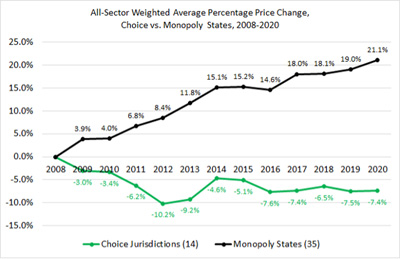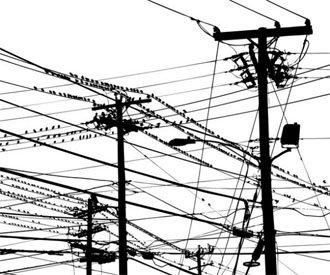A newly released report from the U.S. Energy Information Administration reveals that Oklahoma’s electricity prices are climbing at the fastest rate in the nation. From June 2021 to June 2022, electricity prices surged from 7.3 cents per kilowatt hour to 10.87 cents per kilowatt hour across all sectors (residential, commercial, industrial, and transportation).
That 49 percent increase is the largest percentage increase experienced by consumers in any state. Among all 50 states and the District of Columbia, the average electricity cost increase across all sectors was just 14 percent.
In June 2021, Oklahoma had the most affordable electricity in the nation across all sectors. In June 2022, Oklahoma ranked 18 for most affordable electricity in the nation and ranked last in the West South Central region, behind Texas, Louisiana and Arkansas.
Looking at costs for just residential customers, Oklahomans have experienced a 31 percent increase in June 2021 to June 2022, also the largest cost increase for residents in any state.
Mike Boyd, the executive director for the Alliance for Electrical Restructuring in Oklahoma, said the massive surge in costs indicate the current system in Oklahoma is broken.
“Oklahomans are at the mercy of monopoly utilities that are demanding rate increases while they reap record profits,” said Boyd. “Customers, meanwhile, have no options, no recourse, and no way to escape being ripped off.”
OGE Energy Corp. (OG&E’s parent company) reported annual net income of $360 million in 2021, while American Electric Power (PSO’s parent company) reported well over $2 billion. OG&E and PSO have successfully petitioned the Corporation Commission for over $1.5 billion in combined rate increases since the beginning of 2021.

Twenty-one states and the District of Columbia currently offer choice and competition in electricity markets for some combination of residential and business consumers. A study by the Retail Energy Supply Association (RESA) reports that electricity prices have decreased by seven percent in the states that have fully adopted choice and competition since 2008. In that same time period, prices increased by an average of 21 percent in monopoly states like Oklahoma.
Boyd says AERO will advocate for legal changes in the 2023 legislative session that would restructure Oklahoma’s electrical market into a competitive market with multiple electricity vendors available for consumers to purchase power.
Let’s hope they also look at durability and recovery after any natural or man made electromagnetic pulse (EMP) or transient electromagnetic disturbance (TED). Oklahomans own a power company. The Grand River Dam Authority was created by the 15th Oklahoma Legislature in April 1935. It was established as a conservation and reclamation district for the waters of the Grand River charged with building dams along the river for the purposes of hydroelectric generation and flood control.
About author: David Arnett was once a daily reporter covering City Hall for the Tulsa Tribune and has been a paid contributor for print and broadcast news teams. Arnett won two national awards as a First Amendment Print Publisher, in 1996 founded Tulsa Today, served seven years as public information officer in local public infrastructure programs, hosted a Tulsa call-in radio talk show for a year and was once senior editor for Power Engineering Magazine the leading industrial publican of the electric power industry. Arnett currently provides communications consulting for select clients. Arnett’s work is also found on arnett.substack.com which provides email distribution to subscribers.




Statement from Alliance for Secure Energy Executive Director Jeff Cloud
I’m troubled by AERO’s blatant misrepresentation of Oklahoma as having the highest electricity rates in our region. This is simply untrue. Reports released by the Public Utility Commission of Texas clearly show that Texas’ deregulated prices are continuing to climb at a dramatically higher rate than Oklahoma’s when comparing 2021 rates to 2022 rates. While Oklahoma electricity prices are at 10.87 cents, Texas is seeing prices between 20 and 30 cents, and some service areas are seeing as much as 150% increase.
It’s important to note that the data in the U.S. Energy Information Administration (EIA) report contains information from ALL reporting sellers of electricity: government-owned electric systems, cooperatives, and investor-owned utilities – both regulated and unregulated. With so many different types of reporting entities sending in their prices, the data does not show how the prices of Oklahoma utilities subject to OCC regulation compare to prices paid by Texas customers subject to the AERO model.
AERO’s proposal would have an extremely detrimental impact on residential electric rates in Oklahoma. AERO has already indicated that the proposed legislation they plan to bring to state leaders in 2023 will not address residential rates at all. Instead, AERO will suggest that customer choice should be limited to only certain commercial and industrial customers and that residential customers should remain regulated. We know, however, that utilities simply cannot deregulate one or two customer segments. If that were to occur, costs could shift to residential customers causing residential rates to skyrocket. It would be inappropriate and inequitable for marketers to cherry pick the largest, most profitable, customers and leave smaller customers holding the bag for the fixed costs of operating and maintaining the vertically integrated utility system.
This negative financial and operational impact on consumers is why it has been nearly 20 years since any state has decided to deregulate its electricity system. Our regulated model has served Oklahoma utility customers well for more than 100 years, allowing us to avoid the uncertain and unmanageable risks of electric deregulation.